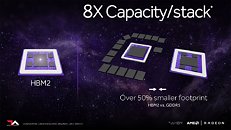Monday, May 15th 2017

AMD Vega Makes an Appearance on CompuBench
An AMD RX Vega video card has apparently made its way towards CompuBench. Granted, the no-name AMD graphics card could be an Instinct accelerator instead of AMD's consumer-oriented RX Vega graphics cards. However, the card did appear on CompuBench under the 6864:00 device ID, which had already appeared under a Vega Linux patch issued by the company. granted, this doesn't necessarily make it a consumer graphics product, so we'll have to look into this with some reservations.We can at least assume this is an RX Vega graphics card - and if other leaks are true, this could be the top of the line RX Vega Nova graphics card. The GPU as identified by CompuBench carries 64 Cus (Compute Units), which, paired with AMD's typical (and confirmed for Vega) design of 64 processing cores per CU, yields the expected 4096 stream processors from the top end Vega. And it would seem that Vega having been built from the ground up with higher frequency in mind is true, with this GPU in particular carrying a 1600 MHz frequency, a far cry from AMD's RX 580's 1430 MHz.Coupled with architecture improvements, this should yield a nice performance boost. The only wrinkle in this CompuBench cameo is the fact that the GPU in question appears with a 16 GB HBM2 memory subsystem, which looks a little out of place from what we know of Vega. We know that showcased dies carried only two HBM2 stacks (at an estimated 4 GB per stack), which would yield a total of 8 GB of HBM2 memory. However, AMD slides on the Vega architecture have shown GPUs surrounded by four stacks of HBM2 memory, so that doesn't mean much. But I have to say that such a grand memory pool on a consumer graphics architecture seems at odds with AMD's approach with their HBCC (High bandwidth Cache Controller), which is supposed to significantly shrink memory requirements by allowing a smart, precise asset allocation to the GPU's memory pool.
Source:
Videocardz






9 Comments on AMD Vega Makes an Appearance on CompuBench
After all to reach 1080Ti level of performance it would need roughly 75% speed increase, not the ~30% at best present there.